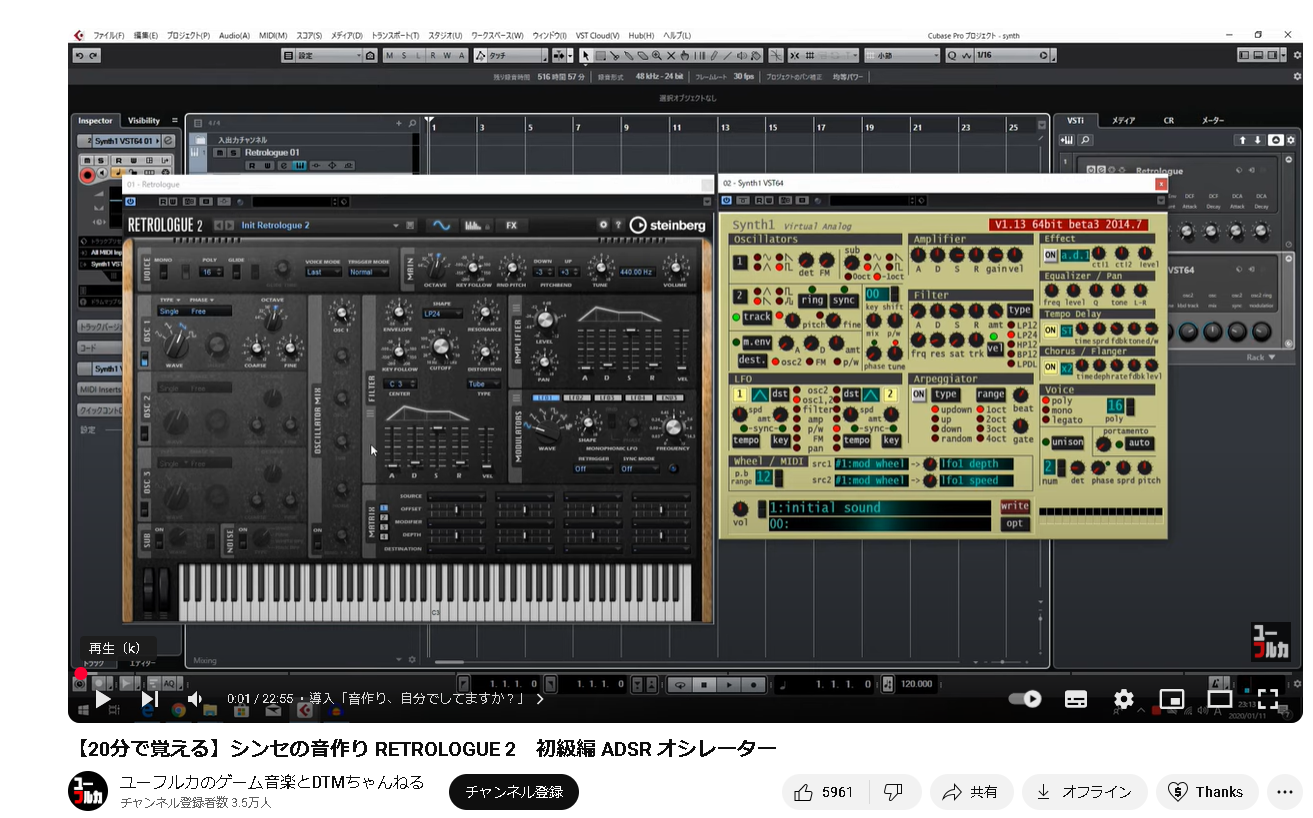はじめに
音作りにおいて、「どんな波形を使うか」と同じくらい重要なのが、音の時間的な変化です。
音はただ鳴るだけでなく、「どのように立ち上がり」「どのように減衰し」「どれだけ続き」「どう消えていくか」といった**ダイナミクス(変化)**を持っています。
このページでは、
ADSRエンベロープによる音量変化の仕組み
5種類の基本波形(サイン波・矩形波・のこぎり波・三角波・ノイズ)
をPythonで視覚的に比較しながら、音の基本構造を理解します。
参考リンクまとめ
エンベロープ(Envelope)とは?
エンベロープとは、音の時間的な変化を制御するパラメータで、音の「鳴り始め〜消えるまで」の音量(Amplitude)や音色の変化を表現します。
特に代表的なのが ADSRエンベロープ です:
| 項目 | 説明 |
|---|---|
| A (Attack) | 鳴り始めから最大音量になるまでの時間(例:ピアノなら一瞬、バイオリンならゆっくり) |
| D (Decay) | 最大音量から減衰して、一定音量に落ち着くまでの時間 |
| S (Sustain) | 鍵盤を押し続けている間、音が保たれる音量(音量の高さ) |
| R (Release) | 鍵盤を離してから音が完全に消えるまでの時間 |
音の立ち上がり方、減衰、持続、消え方を「エンベロープ」でコントロールできます。
アンプ(アンプリファイヤー)とADSR
アンプリファイヤー(amplifier)は音の信号を増幅する回路ですが、シンセサイザーではしばしばエンベロープで制御されるボリューム調整回路として使われます。
具体的には:
- ADSRエンベロープの出力を使って、アンプの音量(ゲイン)を制御
- これにより、鍵盤を押した時に「どんなふうに音が出るか(パンッ、フワッなど)」が決まります
オシレーター(Oscillator)
オシレーターは、音の元となる波形を発生させる装置です。
- 周波数(Hz)で音の高さ(音程)
- 波形の種類で音のキャラクター(音色)
波の種類とその音色の特徴
| 波形 | 特徴 | 音の例 |
|---|---|---|
| サイン波 (Sine wave) | 純粋な音。倍音なし。 | チューニング音、電子音 |
| 矩形波 (Square wave) | 奇数次の倍音を持つ。ブリブリした音 | ファミコン、ゲーム音 |
| のこぎり波 (Sawtooth wave) | 奇数・偶数両方の倍音。明るく鋭い音 | シンセのストリングス |
| 三角波 (Triangle wave) | サイン波に近いが、奇数次倍音あり | ソフトで控えめな音 |
| ノイズ (Noise) | ランダム成分。ピチピチ・ザザッとした音 | ドラム、効果音、風音 |
ADSRエンベロープによる音量変化と5種類の波形の視覚的比較
import numpy as np
import matplotlib.pyplot as plt
# サンプリング周波数と時間軸設定 / Sampling frequency and time axis
fs = 44100 # Hz
duration = 1.0 # 秒 / seconds
t = np.linspace(0, duration, int(fs * duration), endpoint=False)
# ADSRパラメータ設定 / ADSR envelope parameters
attack_time = 0.1 # Attack
decay_time = 0.1 # Decay
sustain_level = 0.7 # Sustain level
release_time = 0.2 # Release
sustain_time = duration - (attack_time + decay_time + release_time)
# 各セクションのサンプル数 / Sample count for each section
a_samples = int(fs * attack_time)
d_samples = int(fs * decay_time)
s_samples = int(fs * sustain_time)
r_samples = int(fs * release_time)
# ADSR エンベロープ生成 / Generate ADSR envelope
attack = np.linspace(0, 1, a_samples)
decay = np.linspace(1, sustain_level, d_samples)
sustain = np.ones(s_samples) * sustain_level
release = np.linspace(sustain_level, 0, r_samples)
adsr = np.concatenate((attack, decay, sustain, release)) # 完全なエンベロープ
# 波形生成関数 / Waveform generation functions
def sine_wave(freq, t): return np.sin(2 * np.pi * freq * t)
def square_wave(freq, t): return np.sign(np.sin(2 * np.pi * freq * t))
def sawtooth_wave(freq, t): return 2 * (t * freq - np.floor(0.5 + t * freq))
def triangle_wave(freq, t): return 2 * np.abs(sawtooth_wave(freq, t)) - 1
def noise_wave(t): return np.random.uniform(-1, 1, len(t))
# 波形データ生成 / Generate waveform data
freq = 440 # A4
waves = {
"Sine": sine_wave(freq, t),
"Square": square_wave(freq, t),
"Sawtooth": sawtooth_wave(freq, t),
"Triangle": triangle_wave(freq, t),
"Noise": noise_wave(t)
}
# --- プロット開始 / Start plotting ---
plt.figure(figsize=(12, 16))
# ① 上:ADSRエンベロープ
plt.subplot(7, 1, 1)
plt.plot(t[:len(adsr)], adsr)
plt.title("ADSR Envelope")
plt.xlabel("Time [s]")
plt.ylabel("Amplitude")
plt.grid(True)
# ② 中:5種類の基本波形(別々にプロット)
for i, (name, wave) in enumerate(waves.items()):
plt.subplot(7, 1, i + 2)
plt.plot(t[:1000], wave[:1000]) # 最初の1000サンプルのみ表示
plt.title(f"{name} Wave")
plt.xlabel("Time [s]")
plt.ylabel("Amplitude")
plt.grid(True)
# ③ 下:ADSR × のこぎり波(例)
plt.subplot(7, 1, 7)
t_env = t[:len(adsr)]
saw_env_wave = sawtooth_wave(freq, t_env) * adsr
plt.plot(t_env, saw_env_wave)
plt.title("Sawtooth Wave with ADSR Envelope")
plt.xlabel("Time [s]")
plt.ylabel("Amplitude")
plt.grid(True)
plt.tight_layout()
plt.show()
デジタルフィルタのボード線図とSI単位接頭辞の表示
import numpy as np
import matplotlib.pyplot as plt
from scipy import signal
# ==== 基本パラメータ / Basic parameters ====
fs = 48000 # サンプリング周波数 [Hz] / Sampling frequency
fc = 2000 # カットオフ周波数 [Hz] / Cutoff frequency
order = 2 # フィルタ次数 / Filter order
# ==== フィルタ設計 / Filter design ====
# ローパスフィルタ / Low-pass
b_lpf, a_lpf = signal.butter(order, fc / (fs / 2), btype='low')
# ハイパスフィルタ / High-pass
b_hpf, a_hpf = signal.butter(order, fc / (fs / 2), btype='high')
# バンドパスフィルタ / Band-pass
b_bpf, a_bpf = signal.butter(order, [fc*0.5 / (fs / 2), fc*1.5 / (fs / 2)], btype='band')
# ==== 周波数応答(デジタル用)/ Frequency response for digital filters ====
w, h_lpf = signal.freqz(b_lpf, a_lpf, worN=1024, fs=fs)
_, h_hpf = signal.freqz(b_hpf, a_hpf, worN=1024, fs=fs)
_, h_bpf = signal.freqz(b_bpf, a_bpf, worN=1024, fs=fs)
# ==== 振幅応答プロット / Magnitude response plot ====
plt.figure(figsize=(10, 6))
plt.semilogx(w, 20 * np.log10(np.abs(h_lpf)), label='Low-pass Filter')
plt.semilogx(w, 20 * np.log10(np.abs(h_hpf)), label='High-pass Filter')
plt.semilogx(w, 20 * np.log10(np.abs(h_bpf)), label='Band-pass Filter')
plt.axvline(fc, color='gray', linestyle='--', label=f'Cutoff {fc} Hz')
plt.title("Bode Plot (Magnitude)")
plt.xlabel("Frequency [Hz]")
plt.ylabel("Gain [dB]")
plt.grid(which='both', linestyle='--', linewidth=0.5)
plt.legend()
plt.tight_layout()
plt.show()
# ==== 位相応答プロット / Phase response plot ====
plt.figure(figsize=(10, 6))
plt.semilogx(w, np.angle(h_lpf, deg=True), label='Low-pass Filter')
plt.semilogx(w, np.angle(h_hpf, deg=True), label='High-pass Filter')
plt.semilogx(w, np.angle(h_bpf, deg=True), label='Band-pass Filter')
plt.axvline(fc, color='gray', linestyle='--', label=f'Cutoff {fc} Hz')
plt.title("Bode Plot (Phase)")
plt.xlabel("Frequency [Hz]")
plt.ylabel("Phase [degrees]")
plt.grid(which='both', linestyle='--', linewidth=0.5)
plt.legend()
plt.tight_layout()
plt.show()
# ==== SI単位接頭辞リストを表示 / Print SI unit prefixes ====
si_prefixes = {
"p": 1e-12,
"n": 1e-9,
"µ": 1e-6,
"m": 1e-3,
"": 1,
"k": 1e3,
"M": 1e6,
"G": 1e9,
"T": 1e12
}
print(" SI単位接頭辞(SI Unit Prefixes)")
for prefix, value in si_prefixes.items():
print(f"{prefix}: {value:.0e}")

